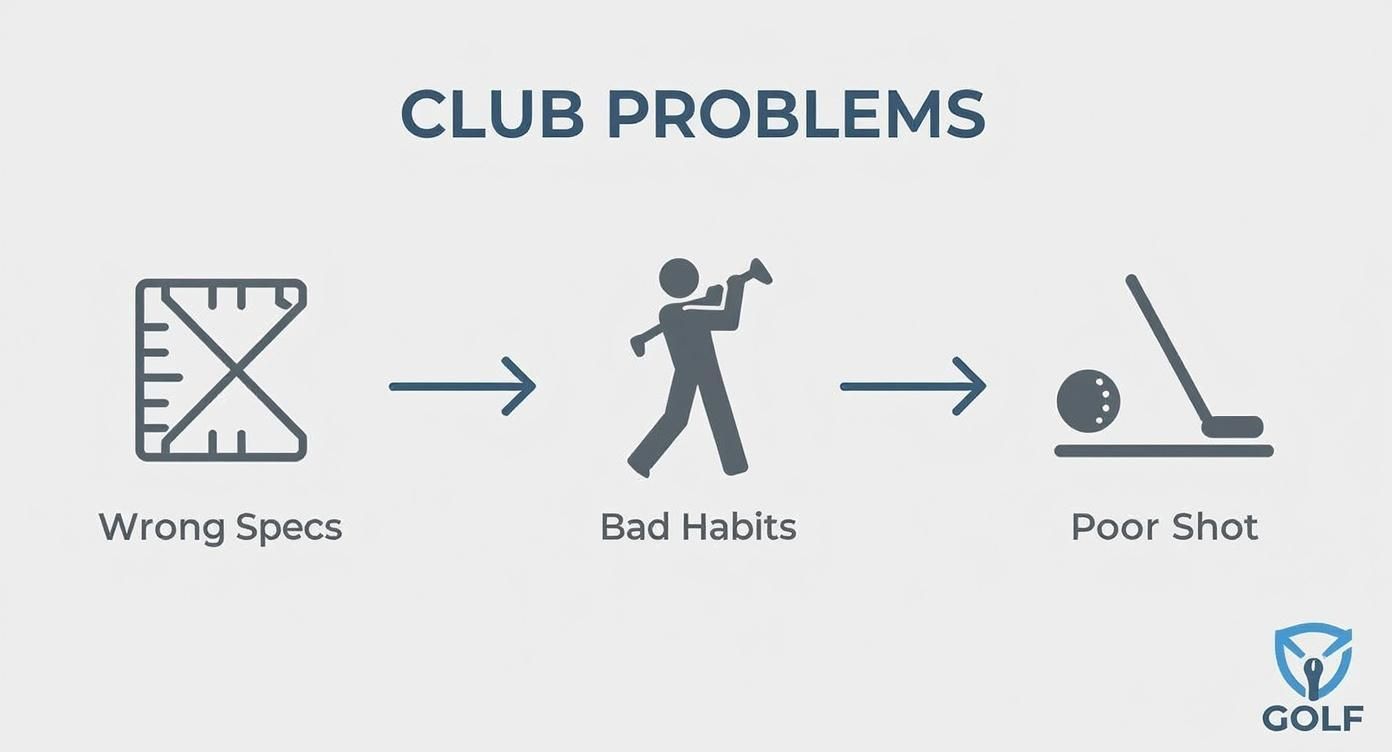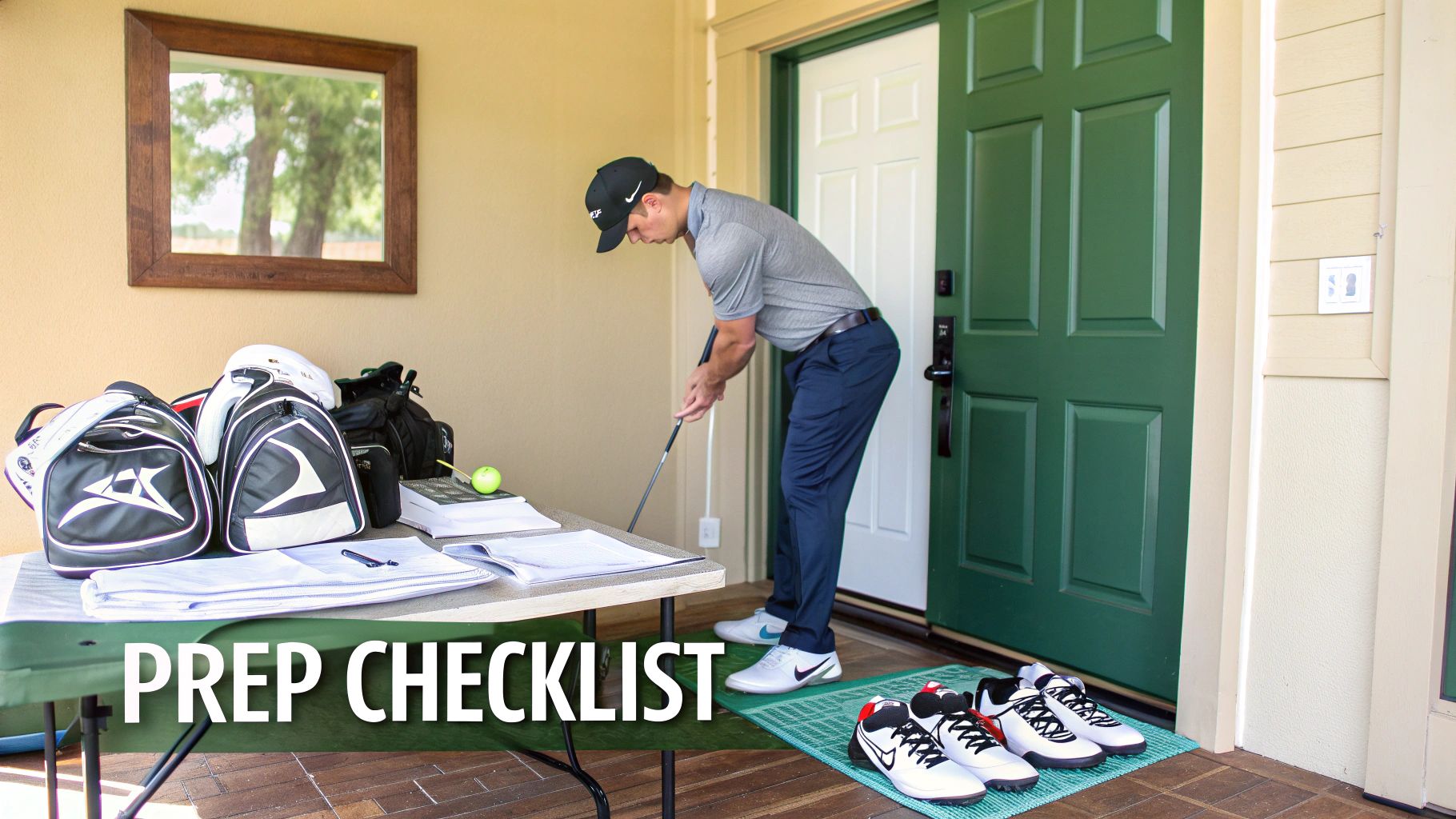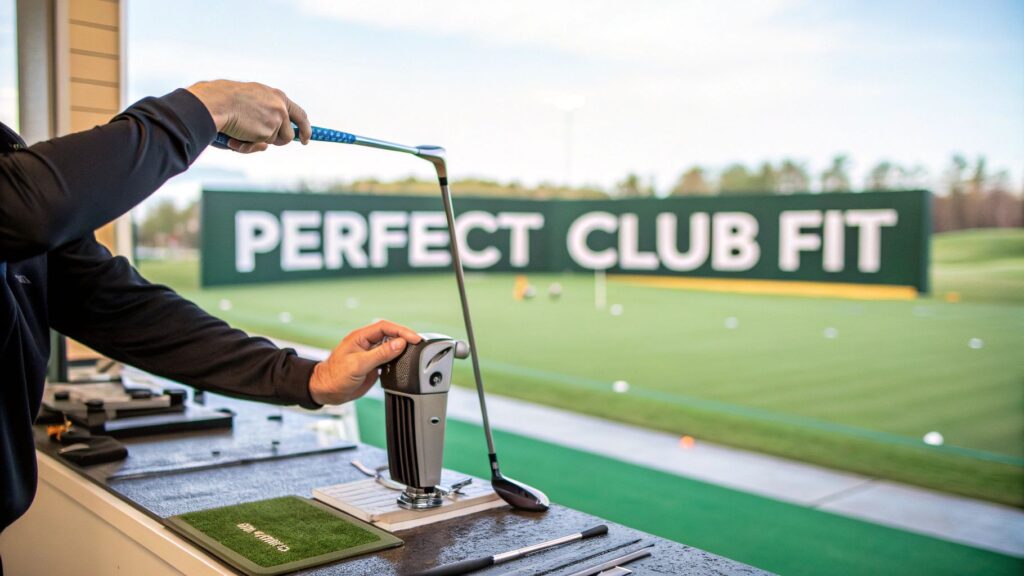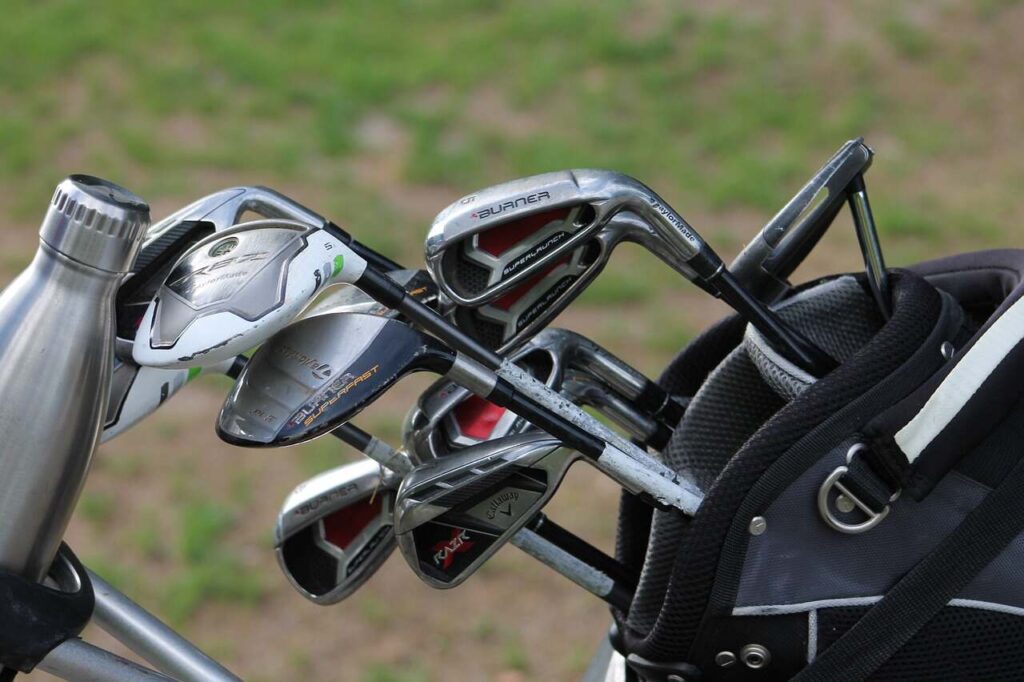A comprehensive golf club fitting guide isn’t just a “nice-to-have”—it’s the single fastest way to improve your game by making sure your equipment actually works with your body and swing, not against it. Instead of forcing your swing to fit a generic, off-the-rack set, a proper fitting tailors every key variable—shaft flex, length, lie angle, you name it—specifically to you. This kind of personalization leads to immediate, noticeable gains in consistency, accuracy, and overall performance.
Why Your Off-The-Rack Clubs Are Costing You Strokes
We’ve all felt it—that incredible, pure sensation of a perfectly struck shot. But for most golfers, that feeling is frustratingly rare. More often than not, the real problem isn’t just your swing; it’s the clubs themselves. Off-the-rack clubs are designed for a mythical “average” golfer who, frankly, doesn’t exist.
Think about the golfer who’s been battling a slice for years. He takes lessons, grinds through swing drills, but that weak, right-curving shot always creeps back in under pressure. He’s convinced it’s his swing path or timing, never once considering that his standard-length clubs are actually forcing him into a steep, over-the-top motion. In this case, the clubs aren’t just unhelpful—they’re actively reinforcing his biggest swing flaw. This exact scenario plays out on courses everywhere, every single weekend.
The Myth of the “Average” Golfer
Manufacturers design standard clubs based on a model of a 5’10” male with a moderate swing speed. If you don’t fit that very specific mold, your equipment is already working against you. This one-size-fits-all approach creates subtle yet significant problems:
- Incorrect Length: Clubs that are too long or short completely throw off your posture and swing plane, which is a recipe for inconsistent contact.
- Wrong Lie Angle: This is the angle of the shaft relative to the sole of the club at address. If it’s off, the clubface won’t be square at impact, causing predictable hooks or slices no matter how good your swing is.
- Mismatched Shaft Flex: A shaft that’s too stiff for your swing speed will feel like a board and rob you of distance. On the flip side, a shaft that’s too flexible can feel whippy and lead to wild inaccuracy.
These mismatches force you to make constant, subconscious compensations in your swing. You’re not building sound mechanics; you’re developing workarounds that are bound to break down when you need them most. You can dive deeper into these fundamentals in our guide on how to choose the right golf clubs for your game.
A custom fitting isn’t some elite luxury reserved for pros. It’s the most direct path to unlocking your true potential. It removes the equipment variable from the equation so you can focus on improving your swing, not fighting your tools.
The shift toward personalization in golf is undeniable. A recent panel of serious golfers revealed that a whopping 79% have gone through a professional fitting, with the vast majority reporting high satisfaction. This just goes to show how today’s golfers prioritize tailored performance over off-the-rack convenience. You can find more insights on this trend in Golf Datatech’s 2024 report on the evolution of custom fitting in the USA.
Moving away from generic clubs is the first real step toward building a more consistent, enjoyable game.
Inside a Modern Golf Club Fitting Session
Walking into a professional club fitting bay today is a world away from just hitting a few balls into a net at the local driving range. Think of it less as a sales pitch and more like a high-tech diagnostic session for your golf swing. The whole process is a partnership, and it always kicks off with a simple, yet critical, conversation.
Your fitter is going to want to know the ins and outs of your game. What are you trying to achieve? Are you desperate for more distance off the tee? Maybe you just want to find more fairways or finally kick that frustrating slice to the curb. This initial chat is everything—it gives the expert the context they need before diving into the mountain of data they’re about to collect.
Decoding Your Swing Data
Once you grab a club and start swinging, things get interesting. Fitters use incredibly powerful launch monitors, like those from TrackMan or Foresight Sports, to capture dozens of data points on every single shot. This isn’t about guesswork; it’s an objective, unbiased look at exactly what your club is doing at the moment of impact.
While everyone loves to talk about clubhead speed, a true professional is looking much deeper. They’re dialing in on a few key numbers that tell the real story of your performance:
- Launch Angle: This is the vertical angle the ball takes off at right after you hit it. Nailing the right launch angle, especially when paired with the perfect spin rate, is the secret sauce for maximizing your distance.
- Spin Rate: Measured in revolutions per minute (RPM), this shows how much backspin you’re putting on the ball. Too little spin and your shots will just fall out of the sky. Too much, and they’ll balloon up, losing serious distance, especially when you’re hitting into the wind.
- Dispersion: This one is all about consistency. It tracks how far left or right of the target line your shots are landing. A tight dispersion pattern is a beautiful thing—it means you’re consistent, even if your shots aren’t perfectly straight every time.
These metrics are the DNA of your ball flight. A skilled fitter can look at this data and immediately diagnose the root cause of your biggest problems on the course. For example, a golfer who hits a weak, low slice might see on the monitor that their launch angle is far too low and their spin rate is sky-high. That’s a classic symptom of an ill-fitted driver.
You can get a better sense of the tech involved by checking out our guide to the best golf launch monitors.
This infographic does a great job of showing how the wrong clubs can trap you in a negative feedback loop.

As you can see, poorly fitted equipment can actually create the very swing flaws you’re trying to fix, leading to frustrating results on the course.
To help you understand what your fitter is looking at, here’s a quick breakdown of the most important numbers from a launch monitor and what they mean for your game.
Key Launch Monitor Metrics and What They Mean
| Metric | What It Measures | How It Improves Your Game |
|---|---|---|
| Ball Speed | The speed of the ball immediately after impact. | A direct indicator of distance potential. Higher ball speed means more yards. |
| Launch Angle | The vertical angle the ball takes off relative to the ground. | Optimizing this helps you hit the ball the ideal height to maximize carry distance. |
| Spin Rate | The amount of backspin on the ball in RPM. | Too much spin robs distance; too little kills control. Dialing this in is key for both drivers and irons. |
| Dispersion | The pattern of where your shots land relative to the target. | A tighter dispersion means more consistency and more shots hitting the fairway or green. |
| Attack Angle | The vertical path of the club head at impact (up or down). | Crucial for drivers. Hitting up on the ball (positive attack angle) helps increase launch and reduce spin. |
These data points are the building blocks of a great fitting. They move the conversation from “I think this feels better” to “I know this performs better.”
From Data to Discovery
With a clear, data-backed picture of your swing, the fitter then starts the real work: finding the perfect club head and shaft combination for you. You’ll hit a bunch of different options while they make small tweaks, comparing the data from each setup until they land on the one that gets your numbers just right.
It’s a true story of discovery. I’ve seen a simple change—like swapping a shaft with a different kick point or trying a club head with a touch more forgiveness—instantly turn a player’s dreaded slice into a powerful, high draw.
You’ll see the improvement for yourself, in real-time, on the monitor. Your dispersion circle will get smaller, your ball flight will look stronger, and you’ll start seeing the distance you know you’re capable of.
This isn’t just about getting a technical breakdown of your swing. It’s about building confidence. You walk out of that fitting not just with a list of specs, but with a real understanding of why those clubs are the right ones to help you play your best golf.
The Shaft Is The Engine Of Your Golf Club
While that sleek, high-tech club head gets all the attention, any experienced fitter will tell you it’s just along for the ride. The shaft is the real engine of your golf club, the component that dictates how your swing’s energy actually gets to the ball.
Think of it like the transmission in a race car. If it’s not matched to the engine, all that horsepower goes to waste. The same thing happens in golf.
Most golfers get hung up on simple “regular” or “stiff” flex labels, but that’s barely scratching the surface of what a shaft does. A true professional fitting dives much, much deeper to analyze the specific properties that influence your launch, spin, and control. Understanding these elements is the first step toward having a productive conversation with your club fitter.
Beyond Simple Shaft Flex
To really dial in your performance, a fitter looks at three key shaft characteristics. Each one plays a unique role in solving a different ball flight problem. Finding the perfect cocktail of these three elements for your swing is where the magic of a great fitting happens.
Here are the big three:
- Kick Point: This is the specific spot on the shaft that bends the most during your downswing. A low kick point bends closer to the club head, helping pop the ball up for a higher launch—perfect for players who need help getting the ball airborne. A high kick point bends closer to your hands, creating a lower, more piercing flight for those with faster swings who might hit it too high.
- Torque: Measured in degrees, torque is all about how much the shaft twists during the swing. A shaft with low torque resists twisting, giving you a firmer feel and helping players with aggressive swings tighten up their shot dispersion by reducing hooks and slices. In contrast, a shaft with higher torque can feel a bit smoother and actually help players with slower tempos square the clubface more easily.
- Weight: Shaft weight is absolutely critical for your tempo and overall control. A lighter shaft can help you generate more clubhead speed and pick up distance. Go too light, though, and the club can feel unstable, leading to wild inconsistencies. A heavier shaft often gives stronger players with faster tempos a greater sense of control and stability through the swing.
Let’s put this into a real-world scenario. Imagine a golfer who struggles with a low, weak slice. They could see a massive improvement from a shaft that is lighter, has a low kick point, and slightly higher torque. This combination makes it easier to swing faster, launch the ball higher, and square the clubface at impact. It’s a triple win.
The right shaft won’t just fix a flaw; it unlocks your best possible swing. It allows you to deliver the club head to the ball with maximum efficiency and consistency, which is the secret to repeatable, powerful shots.
Ultimately, the shaft’s job is to complement your unique swing signature. A fitter uses launch monitor data to test different combinations of kick point, torque, and weight, methodically hunting for the one that optimizes your launch angle, spin rate, and accuracy. This detailed process is exactly why the shaft is the most important—and most personal—piece of the equipment puzzle.
How To Prepare For Your Fitting Session

Getting the most out of your fitting starts way before you ever set foot in the studio. If you just show up cold, you’re missing a huge opportunity. A little prep work turns a simple equipment demo into a strategic investment in your game. Think of your fitter as a partner—the more you give them to work with, the better they can dial in your setup.
First things first, bring your current set of clubs. This is absolutely non-negotiable. Your fitter needs to see what you’re working with right now to establish a performance baseline. Hitting your own 7-iron gives them hard data on your current carry distance, spin rates, and typical shot pattern. That baseline becomes the number to beat.
Without it, the whole session is just a guessing game. You’re not just looking for a club that feels better; you’re hunting for measurable, data-driven improvement.
Set The Stage For Success
To make sure the data you’re gathering is legit, you have to treat this like a real round of golf. That means showing up ready to play.
- Wear Your Golf Shoes: This might seem small, but it’s huge. Your shoes are your connection to the ground, and they directly impact your posture and balance. Hitting balls in trainers or dress shoes will mess with your swing and skew the numbers.
- Bring Your Glove: Your glove is your only point of contact with the club. Using the same one you play with keeps the feel consistent from swing to swing.
- Don’t Show Up Wiped Out: A fitting session means hitting a lot of golf balls. Come in rested and hydrated. Your 100th swing of the day needs to be just as good as your 10th for the data to be reliable.
The single most important thing you can do is be honest about your game. Your fitter isn’t there to judge your slice or your high handicap—they’re there to help you fix it. The more open you are about what you want to achieve and what frustrates you, the quicker they can find the right gear for you.
Finally, walk in with a clear goal and a budget in mind. Are you chasing more distance? Tighter dispersion? Or do you just want a more forgiving set of irons so you can enjoy the game more? Knowing your priorities helps the fitter narrow down the options to what actually matters to you.
Being upfront about your budget is just as important. It keeps the recommendations realistic and ensures the entire golf club fitting guide process is productive and free of any awkward conversations.
What Happens After The Fitting Is Done
So, you’ve dialed in your specs and picked out your new sticks. Awesome. The diagnostic part is over, but your journey with your new custom clubs is just getting started. It’s easy to think the process ends when you walk out of the fitting bay, but now we move from fitting to building.
Your custom clubs aren’t just sitting on a shelf waiting for you. They have to be built from the ground up to the exact specs you found during your session—that means the perfect length, lie angle, shaft, and grip combination. This custom assembly takes a bit of time.
Generally, you can expect a build time of around 2 to 4 weeks, though this can vary depending on the manufacturer and if all the components are in stock. Your fitter will give you a solid ETA and should keep you in the loop as things progress.
The Initial Adjustment Period
When that big box finally shows up, the urge to rip it open and head straight to the first tee is strong. My advice? Pump the brakes and head to the driving range first.
Your new clubs are probably going to feel a little different, and believe it or not, that’s a good thing! It’s a sign that the clubs are now matched to your best swing, not the one you were using to compensate for ill-fitting equipment.
Give yourself a few solid range sessions to get comfortable. Just focus on making your normal, free-flowing swing and let the club do what it’s designed to do. You should start seeing that consistent, ideal ball flight you saw on the launch monitor during your fitting.
Trust the data. It’s so easy to slip back into old swing habits, but remember, your fitting was all about objective performance. These clubs are built to reward your best swing, so give yourself the time to find it and groove it.
Don’t be surprised if your distances have changed a bit, especially with your irons. This is totally normal. A big part of this initial period is “gapping” your new set. Spend some time on the range hitting each club to figure out your new carry distances. Knowing your numbers is a huge confidence booster before you put them into play on the course.
Try not to get frustrated or blame the clubs if you hit a few clunkers at first. An adjustment period is a standard, necessary part of the custom-fitting process. Have faith in the fitting you went through and the data you gathered. Before you know it, that new feel will become second nature, and you’ll really start to see the difference on your scorecard.
FAQ’s
Of course, a guide is great, but it’s totally normal to have a few questions rattling around in your head before you pull the trigger on a fitting. The world of custom golf equipment can feel a little intimidating at first, but nailing down these last few details will give you the confidence you need to invest in your game.
Let’s clear up some of the most common questions I hear from golfers just like you.
How Much Does a Golf Club Fitting Cost?
This is always the first question, and for good reason. The cost of a professional fitting can vary, but you should budget somewhere between $100 to $150 for a specific part of your bag, like just your driver or a new set of irons.
If you’re ready to go all-in and get every club dialed in, a full-bag fitting will usually run you between $300 and $500.
Now, think of that fee less as a cost and more as an insurance policy for your game. Most top-tier fitters will actually credit some, or even all, of that fee toward the new clubs if you buy from them. This move basically makes their expertise free, and it keeps you from dropping a grand on an off-the-rack set that’s completely wrong for your swing.
Do I Need to Be a Good Golfer to Get Fitted?
I hear this all the time, and it’s easily the biggest myth in golf. The answer is a hard no. In fact, it’s often the beginners and higher-handicap players who see the most dramatic, game-changing improvements from a fitting.
You don’t need a picture-perfect swing to benefit. You just need your swing.
A good fitter finds equipment that forgives your specific miss. For instance, if you’re fighting a nasty slice, they can match you with a head and shaft combo that makes it way easier to square the clubface at impact. Getting fit isn’t some prize you win for playing well—it’s a shortcut to getting better, faster.
Getting a new golfer custom-fit builds a proper foundation right from the get-go. It ensures their gear encourages good habits instead of forcing them to develop weird compensations for clubs that are too long, too heavy, or sitting at the wrong lie angle.
Can My Current Clubs Be Adjusted?
Absolutely. This is a fantastic and budget-friendly way to get the benefits of a fitting without having to buy a whole new set. A skilled club builder can make several game-changing tweaks to the clubs you already own.
The most common adjustments are:
Bending the Lie Angle and Loft: This is a must for irons. A fitter can bend the hosel to make your clubs more upright or flat, which has a direct impact on your shot direction and how the club cuts through the turf.
Adjusting Shaft Length: They can easily shorten your shafts or pop in an extension to get the length perfect for your height and posture.
Putting on the Right Grips: It sounds so simple, but getting the right grip size can completely change how the club feels and how much control you have.
These might seem like small changes, but they can make a world of difference. It’s the perfect first step for anyone just starting to explore the world of custom-fit clubs.
At Golf Inquirer, we believe that playing with equipment tailored to your unique swing is the key to unlocking more joy on the course. We hope this guide has armed you with the knowledge to take the next step in your golf journey. To continue exploring tips, gear reviews, and insights that will elevate your game, visit us at https://golfinquirer.com.



